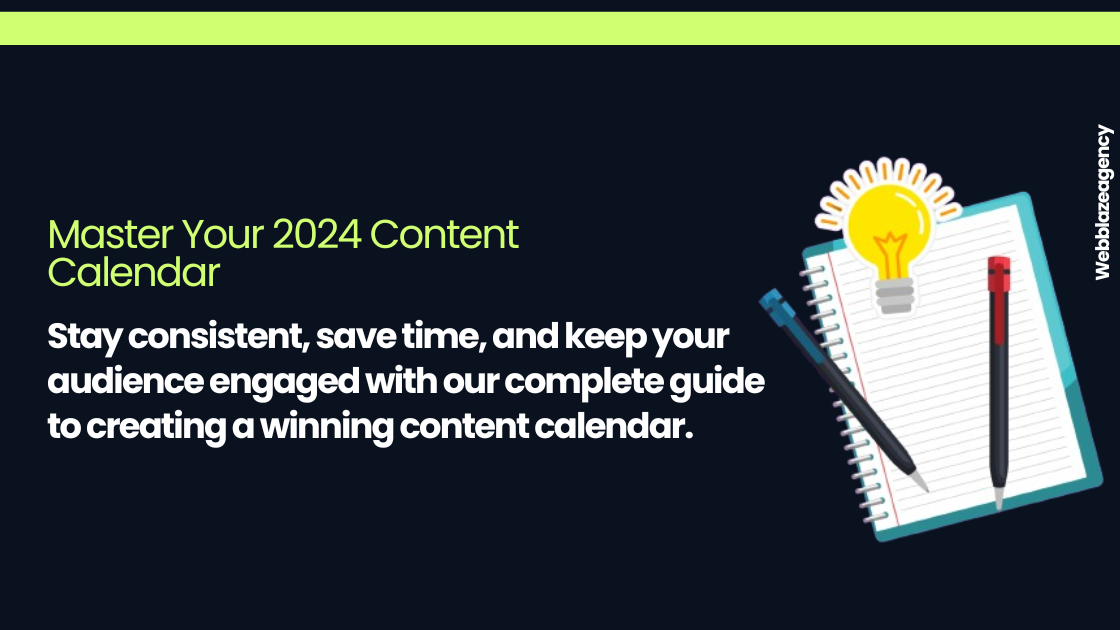In today’s fast-paced world of content marketing, a solid content calendar isn’t just a “nice-to-have”—it’s essential. Think about how much content is out there right now. Between social media, blogs, videos, and emails, it can be easy to get lost in the noise. But with a clear, strategic plan, your content can stand out, consistently engage your audience, and support your marketing goals.
Whether you’re a solo marketer or part of a larger team, this guide will walk you through creating a content calendar that brings clarity, structure, and purpose to your content efforts in 2024.
What Is a Content Calendar and Why It Matters
A content calendar is your plan for what you’re publishing, when you’re publishing it, and where it’s going. But it’s more than just a list of dates—it’s a strategy that aligns each piece of content with your overall marketing goals, your audience’s needs, and your brand voice. Imagine it as the playbook that keeps everyone on the same page, ensuring your content is valuable, timely, and engaging.
In short, your content calendar keeps your team organized, avoids last-minute rushes, and helps you stay consistent with your messaging. It’s the backbone of any successful content strategy, providing both a big-picture view and the fine details to make sure each post, article, or campaign is right on target.
Key Benefits of Using a Content Calendar
Why is a content calendar so valuable? Here’s what you get out of it:
- Consistency and Reliability: When you plan ahead, you’re less likely to miss important dates or publish rushed, low-quality content. Consistent posting builds trust, and audiences are more likely to return when they know they can rely on you.
- Streamlined Workflow: With a calendar in place, you can assign roles, set deadlines, and keep everyone on track. This organization boosts productivity and reduces confusion, especially when multiple people are involved.
- Goal Alignment: Every piece of content should have a purpose. Your content calendar ensures that each post, video, or campaign aligns with your brand’s bigger goals, whether that’s driving traffic, boosting engagement, or generating leads.
- Better Resource Allocation: Planning helps you see what resources you’ll need—like visuals, copywriting, and ad budgets—so you can manage your time and resources effectively.
How to Create an Effective Content Calendar in 8 Steps
Ready to get started? Here’s how to build a content calendar that keeps you on top of your game.
1. Define Your Audience
Who is your content for? Start with a clear picture of your audience, from their pain points to their content preferences. Use data, surveys, and personas to get specific—knowing your audience will help you create content that truly resonates.
2. Set Clear Goals
What do you want your content to accomplish? Are you aiming to increase brand awareness, drive sales, or build a loyal community? Having clear goals helps keep your content focused. Make these goals specific and measurable, like “Increase social media engagement by 20%” or “Generate 50 new leads per month.”
3. Identify Key Topics and Themes
Outline broad themes or topics for each month or quarter. This could be industry news, how-tos, product features, or seasonal trends. Having a few core themes keeps your content focused and makes it easier to brainstorm ideas.
4. Brainstorm Content Ideas
Now it’s time to get creative. Using your themes as a guide, brainstorm a list of content ideas. Keyword research and competitor analysis can help here, but don’t forget to incorporate unique insights and ideas that only your brand can provide.
5. Choose Your Content Types and Platforms
Different platforms call for different content. Decide what types of content you want to create—blogs, social media posts, videos, emails, etc.—and match them to the right platforms. For example, videos might work well on Instagram and TikTok, while in-depth articles fit best on your blog or LinkedIn.
6. Set a Publishing Schedule
Quality over quantity is key. Find a cadence that works for your team’s capacity and stick with it. Are you aiming to post weekly blogs, daily social updates, or a monthly newsletter? Set a schedule that’s consistent but manageable, and remember, it’s better to post less often if that means keeping your quality high.
7. Assign Responsibilities
With your ideas and schedule in place, assign tasks to your team. Identify who will write, design, edit, and publish each piece. Clear roles create accountability and help ensure every piece is delivered on time.
8. Choose Your Content Calendar Tool
There are plenty of options, from simple spreadsheets to comprehensive tools like Asana, CoSchedule, and Trello. Choose a tool that suits your workflow and team size, and one that lets you view, edit, and collaborate on your content calendar in real-time.
What to Include in Your Content Calendar
A well-rounded content calendar isn’t just dates and titles. Here’s what else to add for a complete picture:
- Content Titles or Ideas: Give each piece a working title or theme so it’s clear at a glance what it’s about.
- Publishing Date: Mark down when each piece is scheduled to go live.
- Target Audience: Who’s the primary audience for each piece?
- Channels/Platforms: Where will this content be shared? Think of each platform’s strengths to decide where each piece fits best.
- Keywords: Include keywords you want to target, especially for blog posts and website content.
- Calls to Action (CTAs): What’s the goal for each piece? Include any calls to action to keep each post focused on conversion.
- Status or Stage: Label each piece’s stage in the workflow (e.g., “Drafting,” “Editing,” “Scheduled,” or “Published”).
Best Practices for Timing and Distribution
The “when” and “where” of your content is just as important as the content itself. Here’s how to plan timing and distribution for maximum impact:
Plan Around Key Dates
Be sure to include holidays, industry events, product launches, and other relevant dates. These can serve as anchors for themed content, helping you stay timely and relevant.
Analyze Platform Trends
Each platform has its own “prime time.” For instance, Instagram may see the most engagement in the evening, while LinkedIn does best mid-week. Look at platform data to find optimal posting times, and adjust based on your specific audience’s behavior.
Repurpose High-Performing Content
A blog post can become a series of social media updates, an infographic, or even a short video. Repurposing gives you more mileage out of each idea and lets you reach audiences across different channels.
Examples of Successful Content Calendars
1. HubSpot’s Spreadsheet Template
HubSpot uses a simple, color-coded spreadsheet for managing content. Each row includes the content type, target audience, and keywords, making it easy to manage and update.
2. Hootsuite’s Social Media Calendar
Hootsuite’s calendar is ideal for high-volume social media posting, with a bulk-scheduling feature to keep multiple posts organized and streamlined.
3. CoSchedule’s Marketing Calendar
CoSchedule combines content planning with marketing analytics. It’s a good choice if you need a tool that tracks deadlines and performance metrics in one place.
Top Tools for Managing Your Content Calendar
If you’re just getting started, Google Calendar or Excel can be a simple, effective option. For more advanced needs, consider:
- Trello: A visual, card-based tool that’s great for organizing tasks.
- CoSchedule: A dedicated marketing calendar with features like social media scheduling and team collaboration.
- Airtable: Combines spreadsheet functionality with a flexible interface, making it great for custom setups.
Keeping Your Content Calendar Fresh and Adaptable
A content calendar is a dynamic tool, not a rigid plan. Regularly review what’s working (and what isn’t) so you can refine your strategy. Monthly or quarterly check-ins are great for this—analyzing content performance helps you see what resonates most with your audience.
Consider your calendar a living document, one that grows and adapts alongside your brand. This flexibility will keep your content relevant and engaging in a rapidly changing digital landscape.
Conclusion
A well-crafted content calendar is a powerful way to bring order, consistency, and purpose to your content strategy. It helps you stay organized, align with your goals, and keep your audience engaged. With the right plan, tools, and approach, your 2024 content calendar can be a key driver of success, giving you the structure to create great content and the flexibility to adapt as you go.
So get your team together, start mapping out those ideas, and make 2024 the year your content truly shines.
If you’re looking to build a more comprehensive strategy, check out our Digital Marketing Strategy Guide for tips on aligning your content calendar with your overall marketing goals.

